Menu
Please click on a link to take you to each page.
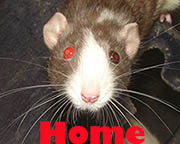
General Care
Personality/Habits
Lifespan
Nail & Teeth trimming
Baths
Introduction/Fighting
Quarantine

Colors & Markings
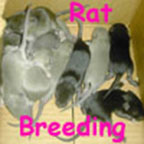
Sexing info
Pre-Breeding info
Pregnancy Info
Baby Info
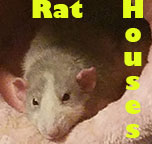
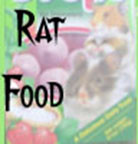
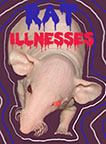
Health Tips
Eyes
Mycoplasma
Pneumonia
Temperature
Bugs
Veterinary Care
Abscesses & Tumors
Bumblefoot
Sprained ankles/Torn toenails
Wounds
Degloving/Tail injury
Aggression
Ears
Megacolon
Barbering
Old Age
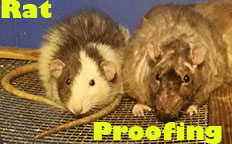
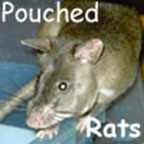

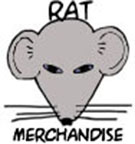
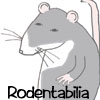
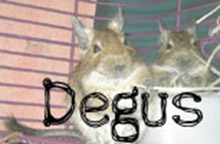
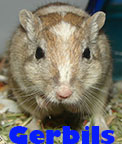
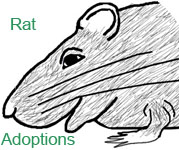
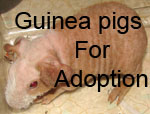
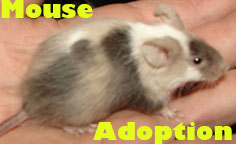
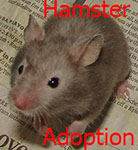
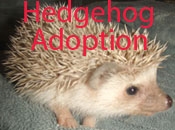
Please click on a picture to take you to each page
80stoysale.com HOME
Menu
Please click on a link to take you to each page.
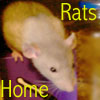
General Care
Personality/Habits
Lifespan
Nail & Teeth trimming
Baths
Introduction/Fighting
Quarantine
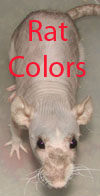
Colors & Markings

Sexing info
Pre-Breeding info
Pregnancy Info
Baby Info



Health Tips
Eyes
Mycoplasma
Pneumonia
Temperature
Bugs
Veterinary Care
Abscesses & Tumors
Bumblefoot
Sprained ankles/Torn toenails
Wounds
Degloving/Tail injury
Aggression
Ears
Megacolon
Barbering
Old Age









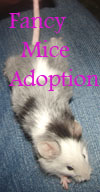


Please click on a picture to take you to each page
80stoysale.com HOME
Menu
Please click on a link to take you to each page.

General Care
Personality/Habits
Lifespan
Nail & Teeth trimming
Baths
Introduction/Fighting
Quarantine

Colors & Markings

Sexing info
Pre-Breeding info
Pregnancy Info
Baby Info



Health Tips
Eyes
Mycoplasma
Pneumonia
Temperature
Bugs
Veterinary Care
Abscesses & Tumors
Bumblefoot
Sprained ankles/Torn toenails
Wounds
Degloving/Tail injury
Aggression
Ears
Megacolon
Barbering
Old Age












Please click on a picture to take you to each page
80stoysale.com HOME
Menu
Please click on a link to take you to each page.

General Care
Personality/Habits
Lifespan
Nail & Teeth trimming
Baths
Introduction/Fighting
Quarantine

Colors & Markings

Sexing info
Pre-Breeding info
Pregnancy Info
Baby Info



Health Tips
Eyes
Mycoplasma
Pneumonia
Temperature
Bugs
Veterinary Care
Abscesses & Tumors
Bumblefoot
Sprained ankles/Torn toenails
Wounds
Degloving/Tail injury
Aggression
Ears
Megacolon
Barbering
Old Age












Please click on a picture to take you to each page
80stoysale.com HOME
Menu
Please click on a link to take you to each page.

General Care
Personality/Habits
Lifespan
Nail & Teeth trimming
Baths
Introduction/Fighting
Quarantine

Colors & Markings

Sexing info
Pre-Breeding info
Pregnancy Info
Baby Info



Health Tips
Eyes
Mycoplasma
Pneumonia
Temperature
Bugs
Veterinary Care
Abscesses & Tumors
Bumblefoot
Sprained ankles/Torn toenails
Wounds
Degloving/Tail injury
Aggression
Ears
Megacolon
Barbering
Old Age












Please click on a picture to take you to each page
80stoysale.com HOME

It is also vital to their health that you know what bedding is safe and what bedding is damaging to their health.
Houses, hammocks, hiding places and toys will provide your rat with a variety of options to keep them occupied when you are unable to play with them.
Than, look at the size of your rats head and make sure the spacing on the cage bars is close enough together that your rat will not be able to escape.
On aquariums make sure the top can be securely closed, so the rat will not be able to push off the lid, if the lid is a little loose, you can put a rock on top to help stabilize it.
The wire is rough on the rats feet and can cause medical conditions such as Bumble foot, or cause the rat to get his foot or leg stuck.
It is O.K. to have some wire cage material to walk on such as on climbing ladders but it is important that the rat does have a hard surface area to walk and sleep on as well.
The bigger the cage the better!
Make sure any and every product you use to clean any of the rats items is safe and not poisonous to you and/or them.
When using a cleaning product to clean a cage, make sure you thoroughly rinse out the cage afterwards (to prevent the rat from getting the solution on themselves and/or ingesting it.)
Providing a rat with shelter is important as it makes them feel safe, and it gives them a good place to take a nap in peace.
Rats love to play, hide and run around, so providing them with houses, beds and toys is important to keep them occupied and to provide them with amusement.
Baby rats and females need cages with 1/4 inch cage bar spacing or less. Adult males can live in cages with up to 1/2 inch cage bar spacing.
No need to worry about poisonous inks as almost all newspaper these days use soy and/or vegetable ink which is safe and non toxic.
Blankets:
Fleece blankets are recommended as they have no strings or stitching your rats nails or toes could get caught on.
You can buy a blanket and cut it up or buy bulk fabric from the fabric store.
Baby blankets work well.
When using cloth towels make sure there are no loose strings or large holes in them. Be very careful on what fabric you use if you are going to drape it over a box to cover a doorway -rats are well known for chewing holes in them and then trying to walk through the newly chewed hole and getting stuck.
Blankets, scarves, & old clothing also works well for rat blankets. (Remove zippers and buttons if the clothing has any.)
Paper towels & Napkins also make good bedding and nesting material. -Especially for Pregnant females.
Water dishes usually don't work well in cages, but rats do enjoy them, so if you have water bottles and water dishes out in the rats free range area this will give them a choice of which they would like to use.
Some rats will dunk their paws and heads under water in water dishes to help clean themselves.
Rats enjoy hammocks to lounge, play and sleep on.
You can buy store bought hammocks for ferrets or other animals but they tend to be/get rather expensive as the rats will chew them to shreds eventually.
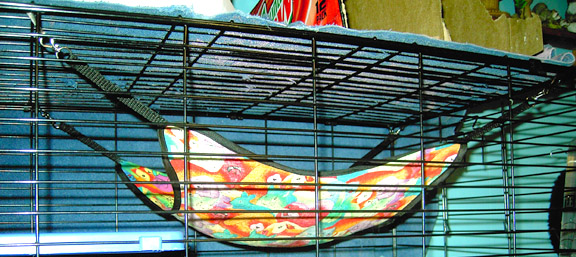
If you have multiple rats living in the same cage it is important to have a few different sleeping areas.
Cheap Hammocks:
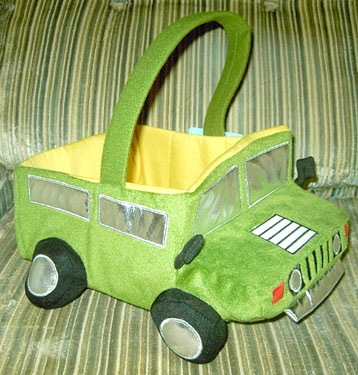
Get a towel, scarf or fabric item and run it through the front and back of the cage bars, decide at what height you want the hammock and make sure you insert the fabric the same number of bars down on both sides. Then pull the fabric up through the bars and wrap it around the bars until it is tight and won't fall down.
You can also cut ties on the ends of the fabric and tie the hammock onto the cage.
You can also use paper clips, clothes pins, twist ties, rubber bands, Velcro, or other types of hooks to hook the hammocks onto the cages.
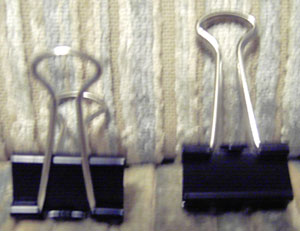

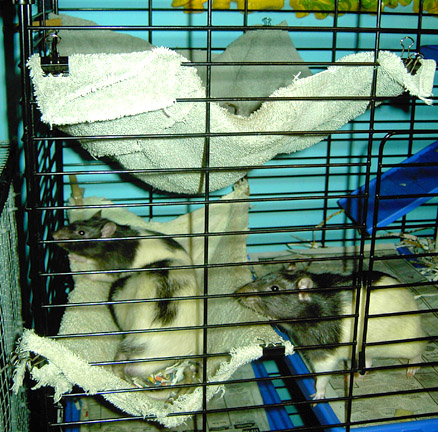
Cardboard houses are not permanent houses, as they will get dirty, run down and urinated on, but they make great temporary houses and sometimes can last months.
To make your cardboard houses last longer and easier to clean you can cover them in clear packaging tape -this allows you to be able to wipe the box surface off from time to time.
If you have more than one rat, it is best to try to make houses with two doors, this way they both can get in and out even if one is sleeping right in front of the door.
Run a few twist ties through the ventilation holes and attach it to their cage for a nice new hiding room so it doesn't go unused.
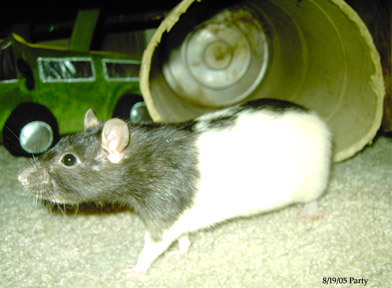
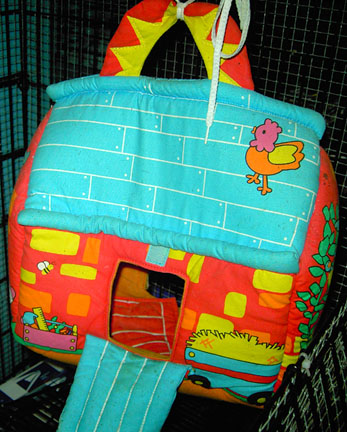
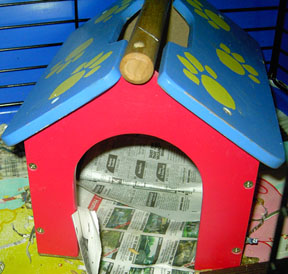
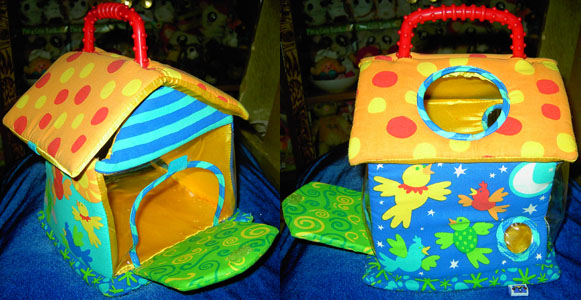
Rats come in all sizes big and small, a Jumbo rat will need more space than a small sized rat.
Several rats will need more space than a lone rat. (Which should be rare -Keep rats in pairs!)
Rats need to have enough space so that everyone can find a spot to sleep in, preferably making several sleeping spots available. This allows the rats to sleep alone or together depending on their moods.
Not all rats get along so it is important to only house rats together that like each other.
The bigger the cage the better, you should be able to tell by knowing your rats size and knowing the size cage you are wanting to house them in how many should fit in their comfortably.
A cage should have more than one level. Half levels are alright -they don't need to be full levels.
If your rats are in an aquarium then boxes and other toys need to be put into the cage so they have places to go and explore and climb.
Baby rats and females need cages with 1/4 inch cage bar spacing or less. Adult males can live in cages with up to 1/2 inch cage bar spacing.
If you are questioning if your cage is large enough for a certain number of rats, than your cage probably should be bigger!
Find a shelf that could be converted into Rat furniture. (I saw this shelf at the Thrift store and knew it was destined to be a rat couch.)
Clean the shelf, find some foam or some sort of soft bedding and cut it to the size it needs to be. You can decide weather you want to make just one bottom cushion or make back and side cushions as well.

Than i covered the foam with a blanket, that way i can take it off and change it for easy washing.

Wooden Doll/Barbie house which i played with as a kid.
I changed the slanted roof to a flat roof, so I could set cages or other items on top.
I spent a few days cleaning, decorating and painting it.
This is a 3 story house, with 10 rooms, 3 staircases & 1 closet.
The house has one section that is 2 stories and another section that is 3 stories high.
This house has Plexi glass windows, has open and closeable front door, garage door and some room doors.
This house is made of wood, and has some vinyl siding in a couple of rooms. The floors are wood, linoleum & carpeting.
This house measures 5 feet wide, 2nd level measures 2 feet 2 inches tall and the 3rd level measures 3 feet 7 inches tall.
The house is complete with rat beds, couches, sticks, toys, food, water and a digging box occasionally filled with growing herbs.
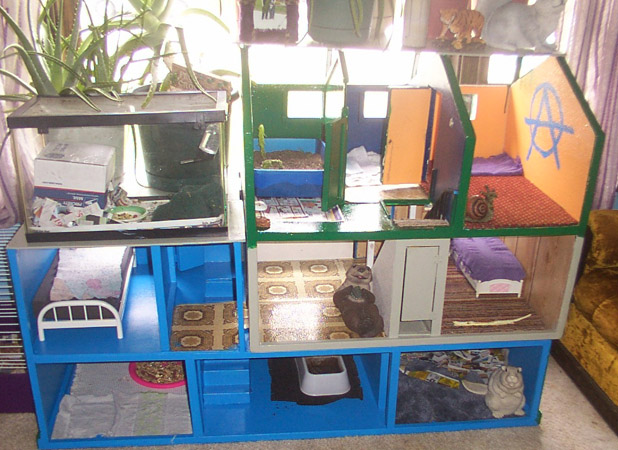
Two story wood shelf rat house, connected by a set of rat stairs.
The stairs are made of wood and covered in fabric to soften them and protect the rats feet.
The top level has a two story box house to hide in.
The bottom level has a Lincoln Lodge wood house to hide in.
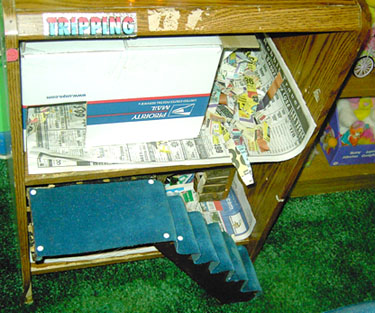
Wooden "Rat shack" two story house with 2 doors on the bottom level and 1 door on the top level.
The roof also opens up from the top.
Inside the house is a small animal bed to add extra coziness inside.
I did some wood burning decorating on the house.
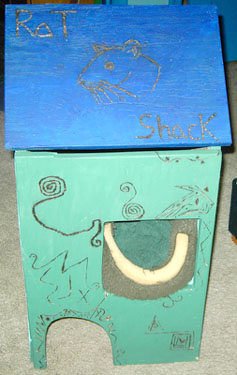
These carpeted houses are great hiding spots for your rats to take a nap.
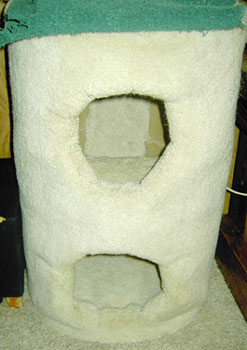
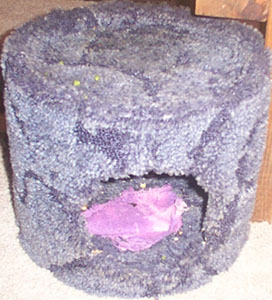
Give your rat, a rat sized couch and maybe, just maybe they won't chew on yours!
Doll couches are perfectly rat sized.

Doll/Barbie beds work great for rats, providing them with a nice and comfy spot to sleep.
Here is a doll -now rat bunk bed.
I put cardboard under the blankets on the bed to keep the rats from falling through, if the blankets get moved around.
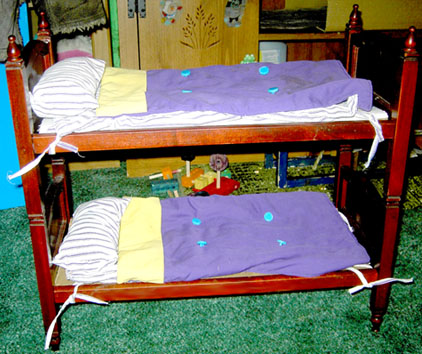
Wooden doll bed & plastic Barbie bed.
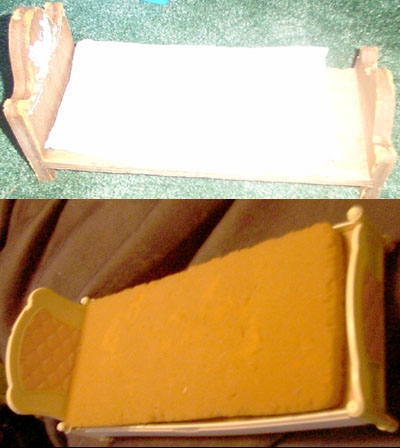
Rat beds, i use these two placed under the bed for them to sleep on.
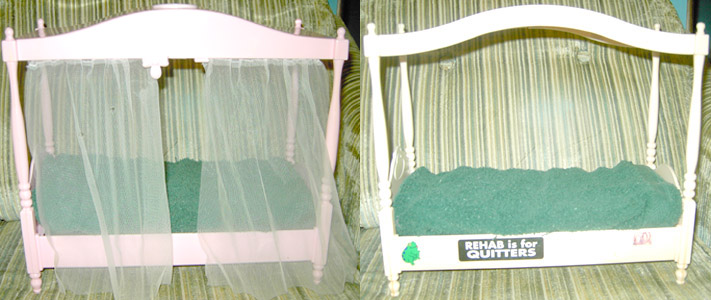
Fisher Price Plastic rat bed
The bed comes apart in two pieces so you can put a blanket in between the pieces to protect from spills. I also have a towel that hangs down in the front, so the rats have more privacy.
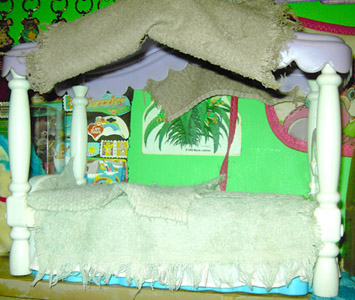
Plastic doll bed, makes a nice hideaway for rat kids.
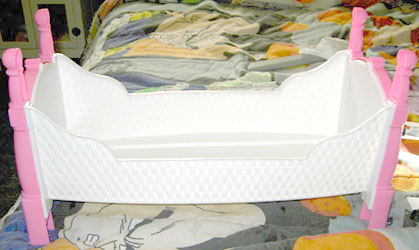
This house has 3 levels. The top level is one room with a ladder leading to the second level. The second level has 2 rooms, and the bottom level has one indoor room and 2 outdoor rooms. I placed a litter box in the back of the house and cover the shelves with newspaper. For some reason the rats really like the second level, and don't go on the other levels as often.
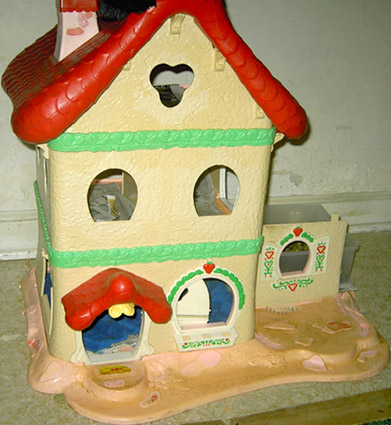
Entertainment stand main bedroom food area.
Floor in front of the food area is covered in place mats to protect the carpet from spills.
In front there are also some bones and wood chew toys.
Bottom level is covered with newspaper, has food dispenser and water dish.
Stairs lead the rats up to the second level where there is newspaper laid down and a box to hide in.
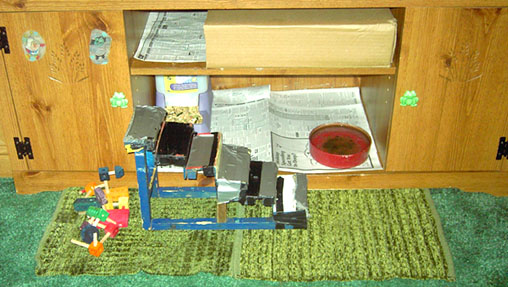
This is the rat area in the headboard area of my bed.
This area includes the top of the headboard, complete with rat hiding boxes.
The lower shelf has two rooms with sliding doors and an open center area with food and water.
Notice i keep a towel over my pillows to protect them from rat messes.
"Rebel" and "Ashes" are in the picture lazing' about.
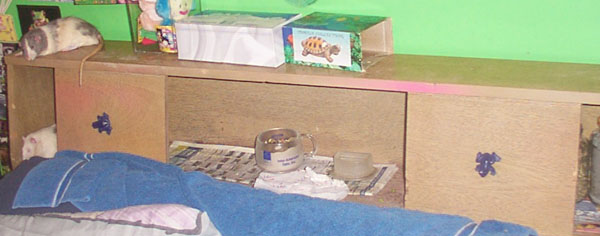
Here is another bed rat area picture with Raindrop.
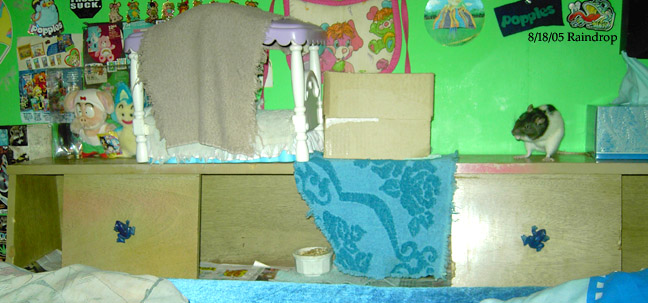
This is a dog bed -turned rat bed! Makes a good place to curl up and hide.
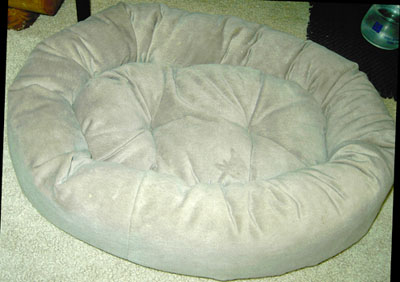
Pound Puppy plastic houses make good rat houses!
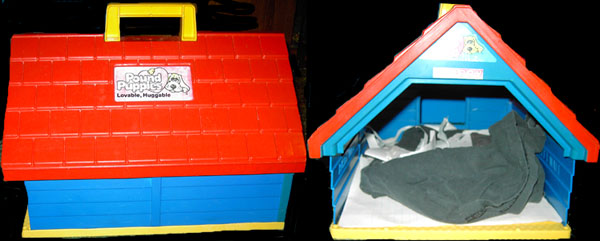
"Lincoln Lodge" wood houses for small animals make a great spot to nap.
They also make a good shelf, such as if put under a rat cage door so they can jump out onto it.
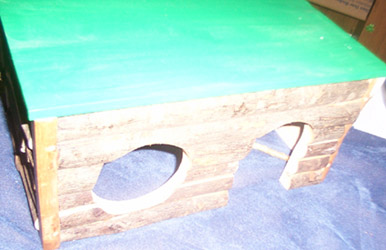
This is a canvas shelf which you hang sideways on the wall, i thought it made the perfect rat tent and the rat kids agree.
(This one was bought at Ikea.)
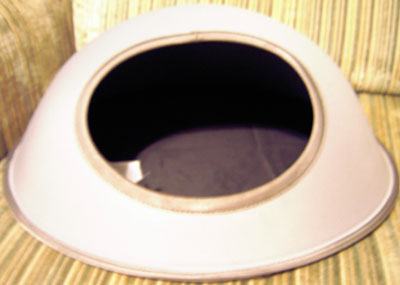
These stairs tend to get moved around quite a bit and have been in many different locations.
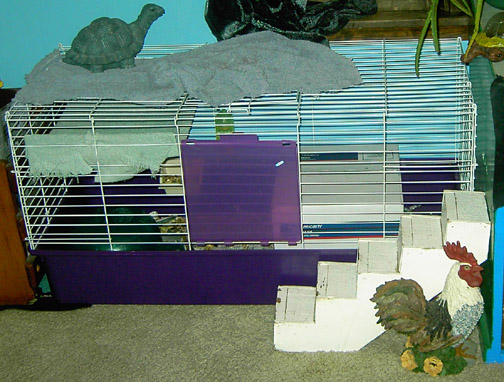
Here are some pictures of the rat cages i use from time to time.
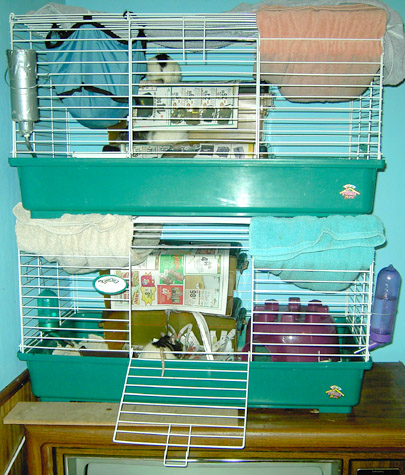
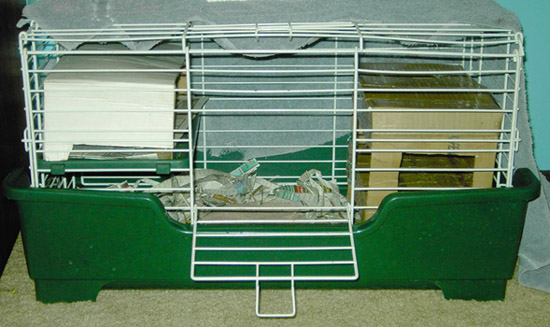
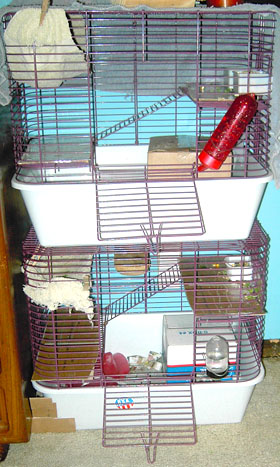
Huge Male Rats cage
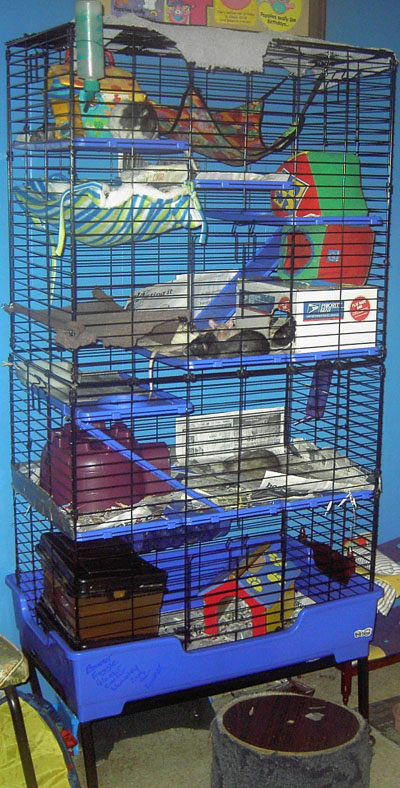
Large Female rats cage..
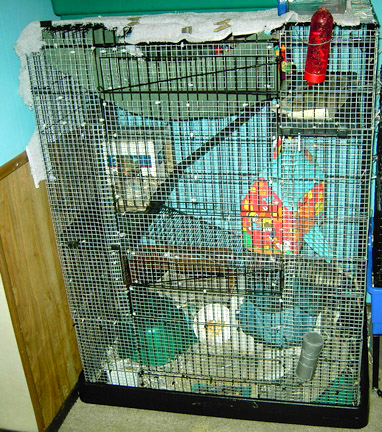
(Plastic balls, balls with bells, etc.)
If you find scabs around your rats neck and you have rats that live or play together watch them and see if they are chewing on each other -before thinking they may have mites or bugs.
Get a small tray or container (litter boxes work great), fill it with dirt, plant some edible plants or herbs and give the box to the rat.
Rat will enjoy many hours of fun digging in the dirt and eating the plants.
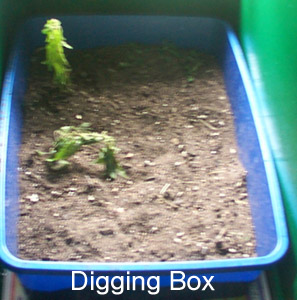
Get a small container (Litter boxes work great) fill it about 1/2 to 2 inches (Depending on how big or small your rat is) and throw in some peas, corn or other treats for the rat to find, and then put your rats inside. It may take them a little while before they notice the food, so you may have to help them find the food. Swimming pools are especially good on hot days.